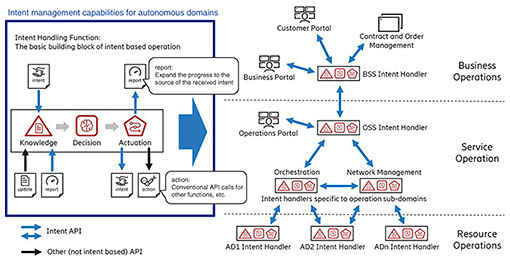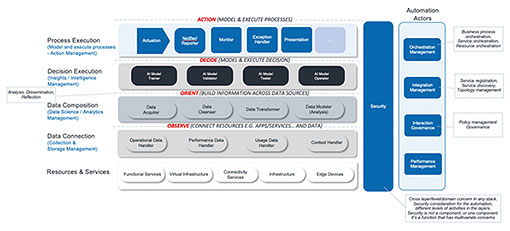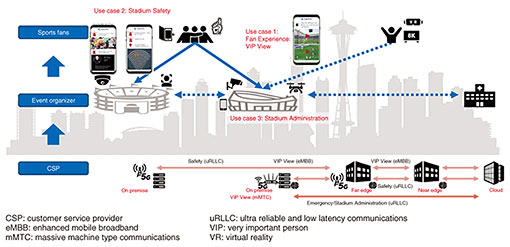 |
|
|
|
|
|
Global Standardization Activities Vol. 21, No. 7, pp. 53–58, July 2023. https://doi.org/10.53829/ntr202307gls Efforts by TM Forum, an Operation Standards OrganizationAbstractThe TM Forum, an organization for standardization of operations, has been actively studying the Open Digital Architecture, which is the architecture of next-generation business support systems/operation support systems, the autonomous operation of networks using artificial intelligence, the use of metrics to penetrate digital transformation, and the transformation to a digitized organization including the skill elements of each individual. In Catalyst (proof-of-concept) projects, which are intended for a variety of business scenarios, efforts to use TM Forum assets for the autonomous operation of networks using intents in Smart-X business scenarios are underway. This article explains these efforts. Keywords: TM Forum, autonomous network, intent management 1. What is the TM Forum?1.1 Positioning and scope of the TM ForumThe TM Forum was established in 1988 as the Open Systems Interconnection/Network Management Forum, a non-profit organization for achieving information and communications network management that can be implemented comprehensively. Activities aimed at promoting network services in cooperation with other industries have been conducted. The forum has more than 850 member companies, including the world’s leading companies in the telecommunications and information technology (IT) industries. 1.2 Themes and projectsThe TM Forum is focused on transforming itself into a digital partner to enable flexible collaboration with other companies. To achieve this, the TM Forum established 6 focus themes: Cloud Native IT & Networks, AI (artificial intelligence), Data & Insights, Autonomous Operations, Beyond Connectivity, Customer Experience & Trust, and The Human Factor, among which 16 projects are being considered (Fig. 1). We describe the efforts of four projects we believe will deeply related to the actualization of NTT’s digital transformation (DX) and IOWN (Innovative Optical and Wireless Network) Cognitive Foundation initiatives. This article also explains Catalyst (proof-of-concept (PoC)) projects at the TM Forum.
2. Open Digital Architecture and Open Digital Framework2.1 Each element and component implementation of Open Digital ArchitectureThe Telecommunications Management Network model defined in ITU-T (International Telecommunication Union - Telecommunication Standardization Sector) M. 3400 has long been implemented in real systems as the business support system (BSS)/operation support system (OSS) architecture. The TM Forum has defined the Open Digital Architecture (ODA) to respond to the radical advancements in operations through collaboration with other business partners, diversification of customer experience (CX), and AI technology. ODA has the following functions:
The Components and Canvas project in the TM Forum is currently in the process of defining the components required for each area of ODA and developing microservices (Fig. 2).
2.2 Open Digital Framework and existing assetsThe Open Digital Framework (ODF), a framework that uses tools and the maturity model, is currently being studied to make ODA a reality. The utilization and mapping of the business-process framework called the enhanced Telecom Operation Map (eTOM), application framework called Telecom Application Map (TAM), and information model called Shared Information/Data Model (SID), which have been conventionally specified in the TM Forum, are being examined. The content of eTOM, SID, and TAM is used as business requirements, information systems, and transformation tools, respectively, for building ODF systems. 3. Autonomous networks3.1 Overall architecture and intentThe study of autonomous networks is aimed at the autonomous operation of networks. As well as at the TM Forum, discussions are being carried out with 3GPP (3rd Generation Partnership Project), ETSI (European Telecommunications Standards Institute) ZSM (Zero-touch network and Service Management) and ENI (Experiential Networked Intelligence), and others on the implementation architecture, model, and application programming interfaces (APIs) of autonomous networks. The overall architecture of autonomous networks is divided into a business-operation layer, service-operation layer, and resource-operation layer, and an autonomous network is achieved by linking the management layers. It also defines the level at which automation is possible and to implement an autonomous network in a gradual manner. The autonomous-network levels L0 to L5 provide definitions for stepping up from manual to automation from the execution, cognition, analysis, decision, intent, and application aspects (Fig. 3).
An autonomous network consists of business, service, and resource layers to enable a closed loop for each layer, automate each management layer in an optimal manner, and overall optimal autonomous operation by linking the closed loops of each layer (Fig. 4). In this context, the goal of each layer’s closed loop is intent, and efforts to use intent as a key to link the layers of an autonomous network are attracting attention. The API and information models needed to achieve these goals are being actively discussed, and many standards-related documents are being developed.
3.2 Closed loopThere are also discussions on reference architectures to achieve autonomous networks through closed loop mechanisms using AI technology. The functions and other aspects of Closed Loop Anomaly Detection & Resolution Automation, which is an architecture to enable automation of the maintenance phase based on ODA, are organized on the basis of the OODA (observe, orient, decide, act) structure, which is a decision-making framework, and the correspondence with specific use cases is summarized in TR 284 Closed Loop Automation Implementation Architecture (Fig. 5).
3.3 Intent Management APIThe Intent Management API is an autonomous network with the role of an intent manager. The API for handling intents among systems such as BSS/OSS and Orchestrator is being studied. The intent manager includes the intent owner, which provides the intent, and the intent handler, which executes the configuration of service resources on the basis of the intent. In addition to creating, modifying, and deleting intents, the following functions, which are necessary for negotiating intents, are also being considered.
4. Connectivity as a Service in the Digital Ecosystem Management project4.1 CaaSConnectivity as a Service (CaaS) is defined as a service in which a user who uses a network service provides the service by specifying only the start and end points and the characteristics required for the network. Users who use the network may not have specific requests or not know about routes in the middle of the network. CaaS is achieved by providing a combination of available services in response to user requirements. An API is being studied to achieve this goal, and a document summarizing the API requirements will be issued in fiscal year 2023. 4.2 Applying intentsCaaS requires users to derive specific services from order content, including vague requirements. Considerations are being made to incorporate the elements of intent discussed in the Intent Management API and apply intent as a condition for offering a 5G network slice. NTT Access Network Service Systems Laboratories (AS Labs) is investigating technologies to extract intents from user and operator interactions and reflect them in network services and is working to standardize use cases and technical requirements as CaaS APIs (Intent Management APIs). 5. Human-factor-related discussions5.1 Digital Organizational Transformation projectAs DX progresses, the Digital Organizational Transformation (DOT) project is being considered to bring the culture and skills of organizations and operators into a continuously evolvable form. In this project, factors such as the digital maturity model (DMM) and customer experience management (CEM) are also considered. The DMM was originally an index used to objectively assess the degree of DX maturity of telecommunications operators and other entities, and using the DMM as an index to assess the maturity of digital culture from the perspectives of culture management, strategic alignment, collaboration, inclusion & diversity, and digital skills & enablement is being discussed. CEM has traditionally focused on each phase of a customer’s recognition, use of a communication service, and the channel through which the customer is approached before finally canceling the service. DOT regards set up for success, frame the transformation, and execute transformation program “Transforming work, organization, skills & culture” as necessary phases for digital-culture transformation and has organized Strategic Leadership, Organizational Modelling and other enablers for each phase. On the basis of these arrangements, the Digital Organizational Transformation Culture and Skills Guidebook analyzes digital culture and shows that it consists of an approach of initiation, realization, persistence, and iterative learning to keep changing the culture. 6. Catalyst (PoC)6.1 Catalyst projectCatalyst refers to the PoC that conducts technology demonstrations at the TM Forum, which consists of a team of carriers and three or more vendors, and exhibits at Digital Transformation World (European event) and Digital Transformation World Asia (Asian event). Through Catalysts, we will increase the number of advocates for technical requirements and support their feasibility and practicality in reflecting the requirements in the standardized documents. This fiscal year 2023’s focus is on Smart X realization, and Catalysts that use metaverses and digital twins and address the ethics of AI algorithms as the governance of AI have attracted attention. 6.2 Catalyst example: Autonomous-network hyperloopsAS Labs is participating in a Catalyst called Autonomous-network hyperloops, consisting of Orange, Chunghwa Telecom, Verizon, TIM, Beyond Now, Futurewei, UBiqube, and NTT (Fig. 6). In fiscal 2023, we entered our fourth term, and since our third term, we have been conducting PoC demonstrations in various service-delivery scenarios on the basis of the intents of event organizers and participants at a smart stadium. In the fourth term, in addition to intent, we have begun to consider scenarios by adding requirements for mission-critical situations. Our Catalyst team won the Outstanding Showcase Award at Digital Transformation World Asia 2023 in March 2023.
|
|
















